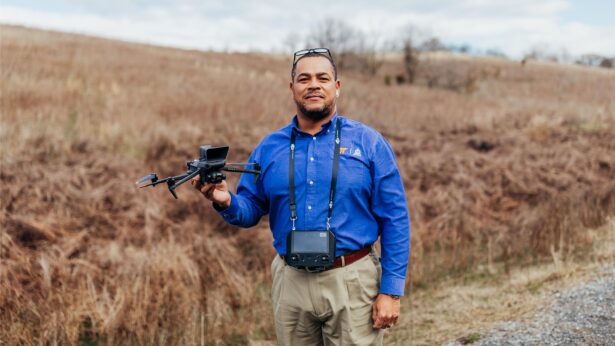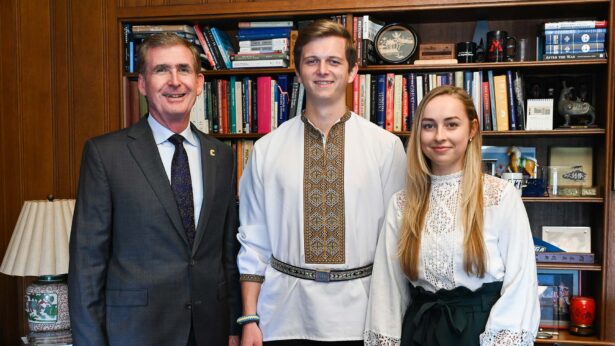Tennessee Alumnus: How would you describe the University of Tennessee and its current standing?
Jan Simek: The University of Tennessee has been very productive during the last decade. We have built relationships with key partners, including the state legislature and the governor, and have become a managing partner of Oak Ridge National Laboratory. We have produced statewide initiatives with real potential for economic impact, but we’ve also cultivated a new faculty and a new student body.
We are a much better university than we were a decade ago. We have the best faculty and students we’ve ever had. We are doing things at a level that we have never been able to do before.
While it’s important for the state’s land-grant university to be an economic engine, the university more directly affects economic growth by creating a cultural and contextual engine for the state, creating an environment in which business can prosper.
It does that by training a highly qualified work force and improving the standard of living—not just in the jobs available and the money people make from those jobs, but in the music they hear when they go to the symphony, the artwork they see in museums, and in architecture and the theater.
The university creates the landscape in which business operates. The best businesses today want creative and productive landscapes for their people because they know their workforce will be more likely to stay with them and be more productive if they and their families are in a dynamic environment. A university is pivotal to that.
The University of Tennessee does that very, very well. We have one of the best theater programs on a U.S. campus at the Clarence Brown Theatre in Knoxville. The music program at UT Martin, with its young, talented faculty provides a cultural milieu that a town like Martin wouldn’t have otherwise.
In Memphis, the UT Health Science Center is developing wellness programs for the community and providing basic healthcare. UT Chattanooga is deeply involved in community affairs—with art programs, for example, and with the architecture and design of the community.
So the university is not just about the economy but also about the environment.
Alumnus: How has UT managed its successes?
Simek: The university’s recent successes are part of the success we’ve had all along, such as the agricultural extension program, and the College of Education at UT Knoxville—the depth of its penetration into the education community in Tennessee is huge. UT’s current initiatives, such as our pursuit of alternative energy sources, are today’s versions of what this university has been doing all along.
Why energy [as a UT research priority]? Quite frankly, because I think our governor and legislature have been visionary. Energy is the problem of our country today and into the future.
The university is engaged because we recognize that basic research and the understanding to address that fundamental problem are central to the survival of our economic system. Our legislature and governor also realize that. That’s what land-grant universities do—educate people and work on society’s fundamental problems.
Alumnus: How did UT get where it is today?
Simek: I think lottery scholarships had a lot to do with getting better students. To be quite honest, the evolution of American education contributed to our ability to attract great faculty prospects. We have an advantage—and have always had, in our ability to attract good faculty—in the place we live. The standard of living is very high compared with some other university communities.
We can offer a lifestyle to our faculty that is really attractive, and we’ve used it, frankly. As a department head and a dean, I used it all the time to attract the best people.
Alumnus: How did the convergence of so many competitive resources and large-scale initiatives come about?
Simek: The faculty was already improving. By the whole nature of the academic world, there are more and more Ph.D.’s because there are more institutions granting them, so you have a better selection, and you can get better people. All of the best chemists don’t go to the Princeton faculty anymore. Because Princeton doesn’t have enough places for all the good chemists, we get some of them.
Student quality began to improve because of the faculty that was in place when the first lottery scholarship students enrolled. These really good students realized they were getting as good an education as they might have gotten if they’d gone off to another school, which is what many of the better students did in the past.
Now the university’s reputation is attracting more good students and faculty. We had that excellent core faculty, and now because the students are good, we are getting better faculty recruits. It’s a snowball effect.
This snowball started ten or fifteen years ago. As we’ve attracted more and more distinguished faculty members, the university’s reputation has risen and we have a better shot at things like National Science Foundation grants.
Alumnus: Does the UT–Oak Ridge partnership mark a significant point?
Simek: Yes, but bear in mind, the collaboration with Oak Ridge—while it’s really important—is only a piece of what a comprehensive university does. It had a profound impact on certain segments, but we have had longstanding collaborations with Oak Ridge, including careers that resulted in national academy memberships, before we became a managing partner of ORNL.
This has always been a good university. As time has gone on, we have built more visibility. It’s not something that happens overnight.
Today we’re considered for programs and possibilities by agencies like the Department of Energy, like the National Science Foundation, that we may not have been considered for before. Reputation is important, and we’ve been building a reputation for a couple of decades.
Alumnus: Will the university develop new Ph.D. programs with ORNL?
Simek: We’re working to develop some joint programs. A closer educational relationship would benefit both institutions. We already have one interdisciplinary degree program within the UT–ORNL Joint Institute for Biological Sciences. More possible programs include a Ph.D. in the Joint Institute for Computational Sciences that might be focused on climate change, and we may do one in the Joint Institute for Materials Sciences. I think we’re very close to having a joint program in neutron science.
Alumnus: What are the benefits and challenges of this?
Simek: The benefits are that we can attract very high quality students interested in the opportunity to work with the wonderful facilities and staff of the national laboratory as well as the faculty here.
Our faculty is already engaged, so these joint Ph.D. programs would give them more opportunities to undertake the research they’re interested in. It’s what they came here to do, in many cases. It’s fulfilling the promise that we made to our younger faculty members when we brought them here.
It gives the lab the ability to interact with some powerful scientific minds at the university.
The lab has an aging workforce. So they will, in the next five to ten years, be looking for a highly trained scientific staff that can replace those that are there now. It’s an obvious step for us to collectively train those people. The lab, the federal government, the Department of Energy, and the state of Tennessee have invested a tremendous amount in the facilities. They must be productively used.
I think it helps both entities in their reputation. It helps the national lab by bringing an academic component to what they do. And for the university, it makes use of remarkable scientific capabilities to address fundamental scientific issues. Many of these issues ultimately will be solved by the development of new materials and structures, and this partnership provides the brain power and the instrumentation for that development.
Alumnus: What kind of opportunities does the best student body create? What does it do to change the university?
Simek: As a teacher, I can tell you that when your students are better prepared and more engaged, you can do more, go farther. The day-to-day activity in the classroom is stronger, and that is exciting for faculty members. It gets them energized. And it pushes students to levels they might not otherwise attain. It raises the bar for everybody. You can feel it in the classroom. It’s a different place than it was five years ago.
Alumnus: What will be the relationship between UT Knoxville and Cherokee Farm?
Simek: I think Cherokee Farm will be a center for scientific development and innovation. There will be partnerships among private enterprise, Oak Ridge National Laboratory, and the university. It’s not going to be a factory or an industrial park. It’s going to be a place where people think problems through and find solutions. The UT Knoxville campus will be deeply ingrained in that. That’s part of its land-grant mission.
Alumnus: When there’s discussion of achieving top-twenty national standing, what effect do visionary projects like those that are supposed to come out of Cherokee Farm have?
Simek: A project like that won’t do it, except insofar as it generates research dollars. What really matters in terms of moving up in standing is to be a comprehensive university of very high quality in all aspects—to have great students and a great faculty publishing at a high rate and being competitive across the board. Big projects help, but they can’t do it alone.
Alumnus: If UT is aspiring to be best, for the trajectory to continue upward, what about those who argue that the state may not be able to afford that kind of university, that perhaps we should simply be more practical?
Simek: That is practical. The economic realities of the world in which we live demand quality in a land-grant university. High-paying jobs will not come to a state that doesn’t have that.
One of the most successful states in terms of high-paying job generation is California—by a long shot. Why? Because the University of California system has five of the top ten public higher education institutions in the United States. Florida has done very well because it has great universities. North Carolina and Virginia have extraordinary land-grant institutions. [Other states] struggle.
States that do well economically do well because there is a university that provides the landscape and the context for productivity, for innovation. It teaches the young people of those great companies, teaches the children of the staff. They want their children to go to a good school, and they’d rather not have to send them off to Princeton because it’s really expensive. Texas, Arizona, California, Illinois, Ohio—every place where there’s economic strength has great public universities.
Alumnus: How do we keep this momentum going?
Simek: These are tough economic times, but as long as we thoughtfully approach problems and deal with them to position ourselves for the future, we’ll be fine, because the trajectory is on a steep upward climb and has been for years. It would take a lot more than a budget [obstacle] to turn that around.
We’ve been through budget downturns before. It’s a cycle. We’ll come out of it.
Interviewer Gina Stafford (Knoxville ’07) is UT assistant vice-president and director of communications.



